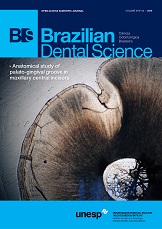Correlation between Body Mass Index and Dental Caries among a sample of Sudanese Children
DOI:
https://doi.org/10.14295/bds.2015.v18i3.1149Abstract
Introduction: Obesity and dental caries have a serious impact on a child’s health; they can be potentially prevented by increasing the knowledge and awareness of proper oral hygiene practice in addition to healthy food consumption. Objective: To determine the correlation between body mass index and dental caries of a sample of 6-11 year old Sudanese children. Materials and Methods: A Cross sectional school based study was conducted. A total of 360 children (50% boys, 50% girls) were examined for body mass index and dental caries prevalence. Physical examination was done by recording the child’s height and weight to calculate the body mass index. Dental caries index was carried out following the WHO criteria. Results: The most prevalent body weight category was normal weight (60.6%) in both genders followed by the underweight group (28.3%), the overweight group (6.4%), and the obese group (4.7%). Boys exhibited a higher prevalence in the underweight category than girls, while overweight was more prevalent in girls (8.3%) than boys (4.4%). The mean dft for primary teeth was 4.68 in both genders and the mean DMFT for permanent teeth was 2.52 and 1.88 for girls and boys respectively. There was a negative correlation between dft and body weight category. No correlation between body weight category and DMFT was found. Conclusion: No correlation between dental caries and age-specific body weight category was found in permanent teeth while in primary teeth the underweight category was more related to the presence of dental caries than the other body weight categories.
Key words: body mass index, normal weight, overweight, obesity, dental caries
Downloads
Downloads
Published
How to Cite
Issue
Section
License
Brazilian Dental Science uses the Creative Commons (CC-BY 4.0) license, thus preserving the integrity of articles in an open access environment. The journal allows the author to retain publishing rights without restrictions.
=================




























